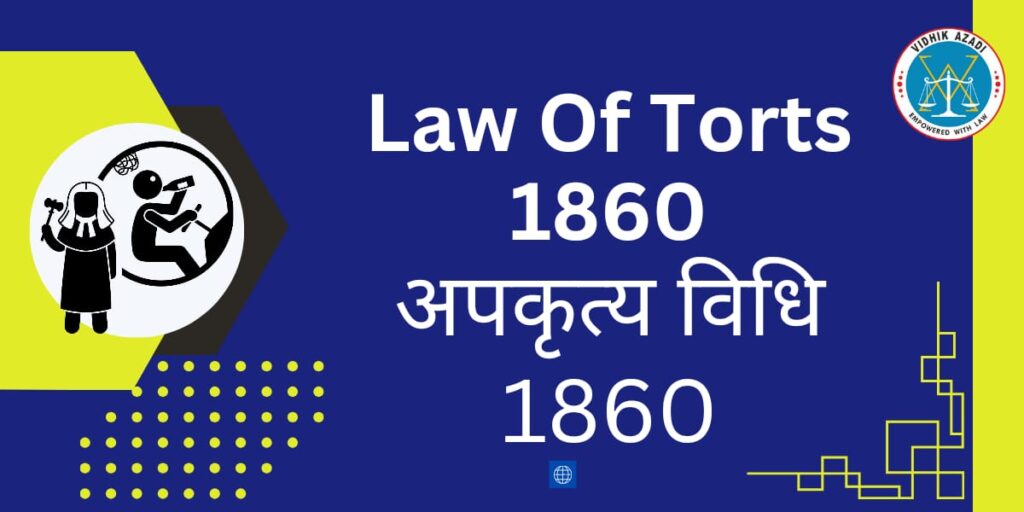Law of Tort

Law of Tort
The Law of Tort in India is a branch of civil law that addresses wrongs committed by one party against another, leading to civil legal liabilities. It is designed to provide remedies to individuals harmed by the wrongful actions of others. While India does not have a codified law of torts, the principles are derived from English common law and have evolved through judicial decisions and interpretations. A tort is a civil wrong that causes harm or loss to someone, for which the law provides a remedy in the form of damages. The primary aim is to provide relief to the injured party and deter others from committing similar wrongs. Intentional torts, Negligence and Strict Liability are its type. It has essential elements such as Duty of Care, Breach of Duty, Causation and Damage. Major Tort principles are Vicarious Liability, Strict Liability, Absolute Liability, Consumer Production and Defamation.
Compensatory Damages to cover the actual loss suffered by the plaintiff. Nominal Damages awarded when a legal right is violated but no substantial harm is done. Punitive Damages to punish the defendant for egregious conduct and deter similar acts in the future. A court order restraining a person from performing a particular act that may cause harm to another through Injunctions. Restoration of the claimant to their original position before the tort was committed through Specific Restitution.
The judiciary in India plays a crucial role in the development of tort law by interpreting and applying common law principles to Indian contexts. Indian courts often refer to and rely on English common law precedents, adapting them to the socio-economic conditions of India. The Law of Tort in India, though uncodified, forms a significant part of the legal system by providing mechanisms for redressal of wrongs and enforcement of rights. The evolving jurisprudence ensures that tort law adapts to new challenges and continues to protect individuals from various forms of harm and injustice.
हानि का विधि
भारत में हानि का विधि (Law of Tort) एक सिविल विधि की शाखा है जो किसी व्यक्ति द्वारा दूसरे व्यक्ति के खिलाफ किए गए अन्यायपूर्ण कार्यों से संबंधित है, जिससे नागरिक कानूनी दायित्व उत्पन्न होते हैं। इसका मुख्य उद्देश्य उन व्यक्तियों को राहत प्रदान करना है जिन्हें अन्यायपूर्ण कार्यों के कारण क्षति हुई है और दूसरों को ऐसे कार्यों से रोकना है। हानि (Tort) एक सिविल अन्याय है जो किसी को हानि या नुकसान पहुंचाता है, जिसके लिए विधि क्षति पूर्ति के रूप में एक उपाय प्रदान करती है। इसका प्राथमिक उद्देश्य घायल पक्ष को राहत देना और दूसरों को समान अन्याय करने से रोकना है। हानि के प्रकार में जानबूझकर की गई हानि, लापरवाही, सख्त उत्तरदायित्व को समहित किया गया है जबकि आवश्यक तत्व के रुप में देखभाल का कर्तव्य, कर्तव्य का उल्लंघन, कारण व क्षति को समाहित किया गया है।
भारत में हानि का विधि के प्रमुख सिद्धांत प्रत्यक्ष उत्तरदायित्व, सख्त और पूर्ण उत्तरदायित्व, सख्त रूप है। वादी को हुए वास्तविक नुकसान को कवर करने के लिए क्षति पूर्ति, नाममात्र क्षति पूर्ति जब कोई कानूनी अधिकार का उल्लंघन हुआ हो लेकिन कोई महत्वपूर्ण हानि नहीं हुई हो तो छोटी राशि प्रदान की जाती है। दंडात्मक क्षति पूर्ति प्रतिवादी को कठोर आचरण के लिए दंडित करने और भविष्य में समान कृत्यों से रोकने के लिए। प्रतिबंध आदेश जो किसी व्यक्ति को विशेष कार्य करने से रोकता है जिससे दूसरे को हानि हो सकती है। विशिष्ट पुनर्स्थापन के तहत वादी को उसकी मूल स्थिति में बहाल करना जैसा कि हानि होने से पहले था।
भारत में न्यायपालिका हानि के विधि के विकास में महत्वपूर्ण भूमिका निभाती है। यह सामान्य विधि सिद्धांतों की व्याख्या और उन्हें भारतीय संदर्भ में लागू करती है। भारतीय न्यायालय अक्सर अंग्रेजी सामान्य विधि के मिसालों का संदर्भ लेते हैं और उन्हें भारत की सामाजिक-आर्थिक परिस्थितियों के अनुरूप ढालते हैं। भारत में हानि का विधि, हालांकि अप्रचलित है, कानूनी प्रणाली का एक महत्वपूर्ण हिस्सा है जो अन्यायपूर्ण कार्यों के लिए उपाय प्रदान करने और अधिकारों को लागू करने के तंत्र प्रदान करता है। विकासशील न्यायशास्त्र सुनिश्चित करता है कि हानि का विधि नई चुनौतियों के अनुकूल हो और विभिन्न प्रकार की हानियों और अन्याय से व्यक्तियों की सुरक्षा करना जारी रखे।
